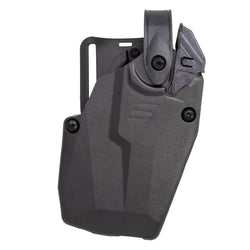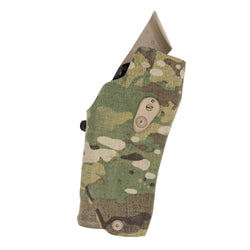Most modern firearm advancements aren’t about creating new calibers or better weapons, but making them more modular. The drive for modularity gave birth to the Picatinny rail system, which has long dominated optic rails and handguns. The next step in modular accessories is a modular system, and the system that currently dominates the modern rifle handguard market is M-LOK.
M-LOK, which stands for Modular Lock, is a firearm rail interface system that’s not weapon-specific. It’s most often used on long guns, like shotguns, rifles, and submachine guns.
M-LOK has become a common term that you’ll run across when shopping for firearms and accessories. It’s everywhere, and companies both big and small have created or use M-LOK systems on their long guns and accessories. Which leaves us with a couple of questions:
- What Exactly Is M-LOK?
- Where did it come from?
- Why has it become so dominant?
- Is it duty-ready?
Let’s dig in and find out.
What Is M-LOK?
Calling M-LOK a modular firearm rail interface system doesn’t exactly clear up what it is. Essentially, it consists of slots built into firearm components that allow direct mounting of accessories, sometimes including Picatinny rails themselves.
You’ll see M-LOK most commonly used on the forend of firearms. This could be handguards, shotgun pumps, or dedicated mounts that attach to the front of the firearm. Additionally, M-LOK slots might be used on stocks to mount sling mounts and similar sling-based accessories. Shooters can mount lights, lasers, bipods, foregrips, and sling accessories on M-LOK rails.

How M-LOK Accessories Attach
These accessories are secured to the M-LOK via a T-Nut. The slots are 32mm long and 7mm wide. Accessories can be mounted directly to the slot or can bridge between multiple slots. To ensure accessories or rails are secure, there is a series of required torque specifications.
- Metal accessories on metal handguards: 35 lb-in
- Any accessory on polymer handguards: 15 lb-in
- Polymer accessories on metal handguards: 15 lb-in
The Benefits of M-LOK
The Picatinny quad rails that came before M-LOK were great, but they were big chunks of metal with slots for accessory mounting. It worked, but it was so heavy. M-LOK reduces weight significantly by using slots instead of long sections of rail. Users can place rails where they want them and call it a day.

Additionally, those old quad rails had a “cheese grater” effect. They were never comfortable to grip. M-LOK provides a smooth tube that’s thinner and easier to hold onto.
M-LOK rails offer a greater degree of customization. You can position your accessories where you want them, and it’s easy to do so. This cuts out the need to use Picatinny rails entirely by allowing the accessories to mount directly to the rail.
History Of M-LOK
Magpul, makers of some of the world’s best firearm accessories, is the company behind M-LOK. But it wasn’t their first attempt at a modular firearm interface system. In 2008, they released something called MOE.

The MOE slot system allowed you to mount MOE-specific accessories and sections of MOE-specific Picatinny rails. The system premiered with a Magpul handguard, and it was somewhat successful.
But MOE had some weaknesses. It required you to be able to access the top and bottom of the handguard at the same time to attach accessories. The MOE slots used a weld nut, so to attach MOE accessories to the MOE handguard, it had to be split into two pieces to attach the accessories, and then put it all back together.

This wouldn’t work with modern free-floating rail systems. In 2008, those were taking over the AR market. Magpul went back to the drawing board, designed M-LOK, and released it in 2014. The big changes were a swap to the metric system and the use of T-nuts.
How IT Came To Dominate
M-LOK wasn’t the only modern, modular rail system that allowed users to put accessories wherever they wanted them. The other big competitor was KeyMod. You still hear about KeyMod every now and then, and some companies still produce KeyMod, but for all intents and purposes, it’s dead.

What killed KeyMod and propelled M-LOK to the top of the pile was a 2017 summary report from NSWC-Crane. NSWC-Crane is the “Q” of the Navy SEALs. They study, develop, and test equipment to find the best weapons and gear for the SEAL teams.
The report showed that M-LOK beat KeyMod in repeatability, failure load testing, and drop testing. KeyMod was blown out of the water. Overnight, KeyMod fell out of popularity, and M-LOK took over.
That’s the reason why M-LOK dominated other systems, but it’s not the only reason. Magpul offers a free-of-charge license. Any gun company can use M-LOK if they get the free license from Magpul.
This allows it to grow and dominate, but also ensures a certain degree of standardization and quality with every M-LOK rail. It’s not an open-source format, but it can still grow and evolve quickly and decisively.
Is It Duty Ready?
The classic Picatinny quad rail has been proven to an extreme degree. Its use during the Global War on Terror puts it in the hall of fame for rifle upgrades. We know Picatinny rails are duty-ready, but what about M-LOK?

It took some time, but M-LOK has entered the duty market. In 2018, the U.S. Army Special Operations Command, aka USASOC, adopted the Upper Receiver Group Improved, aka the URG-I. One of the most notable improvements with the URG-I system was the presence of an M-LOK rail, specifically a Geissele Mark 16 rail.
Beyond the URG-I, we’ve seen batches of Noveske rifles used by SEAL Team 6 with M-LOK rails, and there have been various other upgrades to various rifles within the Special Operations community.

The biggest acceptance for M-LOK comes from the adoption of the Army’s M7 rifle. This is the first general issue firearm I’m aware of that utilizes an M-LOK rail system. The M7 hasn’t reached every corner of the Army, but that’s the end goal.
M-LOK Now and Forever
M-LOK is taking over. It’s become the standard on rifles, shotguns, submachine guns, and most long guns. Even bolt actions and lever actions are getting the M-LOK treatment. It isn’t going anywhere anytime soon and is a testament to the ingenuity that is Magpul.









